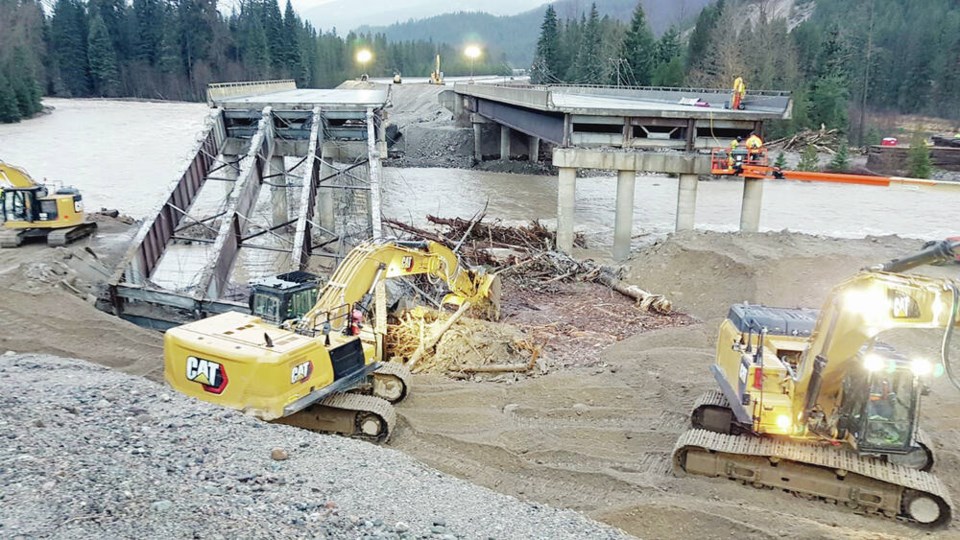Nov. 16, 2021 had to be one of the hardest days in the careers of Jennifer Fraser and Kevin Weicker, senior officials with sa国际传媒’s Ministry of Transportation and Infrastructure. Over the previous two days, an atmospheric river had flowed through our province, bringing deluges of as much as 200 millimetres, flooding the Fraser Valley and washing out huge chunks of our inland highway infrastructure in the process.
That “river” was most likely born near the equator somewhere in the south Pacific. Estimates are that by the time it reached our coast it was probably 1,600 kilometres long and 500 kilometres wide.
When it made landfall, the vapour it contained turned to water, unleashing biblical torrents of rain roughly equivalent to 20 or 30 Fraser Rivers, as it wound its way across the interior.
For Fraser and Weicker, the biggest challenge the next day was simply trying to process what had happened. Sections of every major route in and out of sa国际传媒 had been wiped from the map.
“It was really at those first couple hours and days and getting past the initial shock of the damage, of the devastation, the impact,” said Fraser, executive director of the highway reinstatement program.
“There’s so many thoughts going through everyone’s heads and the biggest challenge was recognizing that we need to quickly get over that shock that happens when there is a big change and quickly pivot to — let’s make a plan, let’s enact that plan and let’s just get at it,” she said.
Getting at it was going to be tough. There were 26 affected sites — 14 where highway lanes were completely obliterated, seven bridges that were damaged or destroyed and five sites where landslides or mudflows blocked highways.
On the Coquihalla corridor alone, dozens of sites, including bridges, were not only wiped out but completely cut off from access. “One of the biggest challenges from the technical side in getting this built is that we lost bridges at the extreme south end and the extreme north end, so we had no vehicle access to a large chunk of the corridor,” said Weicker, executive director for capital projects on the Coquihalla.
Yet, within a day things were moving. Two hundred pieces of equipment were assembled — dump trucks, cement trucks, excavators, huge off-road rock haulers, backhoes and compaction rollers, supported by two hundred operators and workers. Private crews to repair the nearby Trans-Mountain pipeline were also brought in.
The first priority was building construction access for this army. Temporary wooden bridges were built at several choke points, allowing crews to push forward and start road repairs within days.
Then came some heavy lifting. They would eventually move 400,000 cubic metres of dirt to underlay roads and fill damaged gaps. To put that in perspective, if you moved all that dirt at once, the dump trucks required would be lined up from Hope to Kamloops.
That wasn’t enough. Another 130,000 cubic metres of rock, enough to fill 50 Olympic-sized swimming pools, also had to be blasted out and hauled in from nearby quarries.
The worst site was the two bridges at Bottletop that cross the Coldwater River, south of Merritt. “We lost two spans on one bridge and one span on the other bridge and also the road just to the south of the bridge was completely washed out by the river,” said Weicker. That washout made a hole 100-metres long, 10-metres deep and the full width of the highway.
With Trans-Mountain’s assistance, temporary roads and bridges were laid down so that bridge crews could move in and launch heavy steel girders over the still-churning river. The rest of the steel bridge structure had to be assembled in a nearby field and hauled to the site for installation.
At first, the weather was abnormally good. But two weeks before completion, the Coquihalla’s normal December weather returned. “There was one weekend where a storm rolled in and dropped nearly a metre of snow up on the top of the summit and half a metre of snow on some of the construction sites, so that definitely slowed them down,”said Weicker.
It doesn’t seem like much of a slowdown to me. Catastrophic destruction occurred on Nov. 14 and 15, yet commercial vehicles were rolling through by Dec. 20. The rest of us had access by Jan. 18.
Fraser is quick to extend her gratitude to industry and local indigenous communities for their partnership and to the public for their patience.
But I think gratitude also goes to the professionals and crews still slogging away out there. Because of their hard work, we often take for granted how well our systems actually work.



